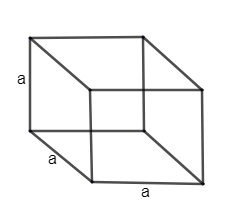
If the perimeter of base of a cube is 14cm and its height is 3.5cm, then its lateral surface area is
(a)36 \[c{{m}^{2}}\]
(b)422 \[c{{m}^{2}}\]
(c)49 \[c{{m}^{2}}\]
(d)56 \[c{{m}^{2}}\]
Answer
600k+ views
Hint: Find the side of the cube with a formula of perimeter of the cube, for which perimeter is given. Lateral surface area of the cube is the area of four sides of the cube.
Complete step-by-step answer:
We have been given the perimeter of the base of a cube as 14cm.
We know that in a square all the sides are equal. Let us take the side of a square as ‘a’. Thus the perimeter of a square is given by the \[4\times \] side.

Thus perimeter of square = 4a.
\[4a=14\]
\[a=\dfrac{14}{4}=\dfrac{7}{2}=3.5\]cm
Thus we got the side of the cube as, a = 3.5cm.
We have been given the height of the cube as 3.5cm, which is equal to \[\dfrac{7}{2}\]cm.
Now we need to find the lateral surface area of the cube.
For a cube, the lateral surface area would be the area of the four sides. If the edge of the cube has length ‘a’ then the area of one square face \[=a\times a={{a}^{2}}\].
Thus the lateral surface of a cube will be the area of four faces \[=4\times {{a}^{2}}\].
\[\therefore \] Lateral surface area \[=4{{a}^{2}}\].
Put, \[a=\dfrac{7}{2}\]cm.
\[\therefore \] Lateral surface area \[=4\times {{\left( \dfrac{7}{2} \right)}^{2}}=4\times \dfrac{7}{2}\times \dfrac{7}{2}\]
\[=4\times \dfrac{49}{4}=49c{{m}^{2}}\]
Thus we got the lateral surface area of the cube as \[49c{{m}^{2}}\].
\[\therefore \] Option (c) is the correct answer.
Note: The lateral surface area of a prism is the sum of the area of the sides of the prism. This LSA can be found by multiplying the perimeter of the base by the height of the prism. In a cylinder, the LSA is \[2\pi rh\], which would be equal to the curved surface area of the cylinder.
Complete step-by-step answer:
We have been given the perimeter of the base of a cube as 14cm.
We know that in a square all the sides are equal. Let us take the side of a square as ‘a’. Thus the perimeter of a square is given by the \[4\times \] side.

Thus perimeter of square = 4a.
\[4a=14\]
\[a=\dfrac{14}{4}=\dfrac{7}{2}=3.5\]cm
Thus we got the side of the cube as, a = 3.5cm.
We have been given the height of the cube as 3.5cm, which is equal to \[\dfrac{7}{2}\]cm.
Now we need to find the lateral surface area of the cube.
For a cube, the lateral surface area would be the area of the four sides. If the edge of the cube has length ‘a’ then the area of one square face \[=a\times a={{a}^{2}}\].
Thus the lateral surface of a cube will be the area of four faces \[=4\times {{a}^{2}}\].
\[\therefore \] Lateral surface area \[=4{{a}^{2}}\].
Put, \[a=\dfrac{7}{2}\]cm.
\[\therefore \] Lateral surface area \[=4\times {{\left( \dfrac{7}{2} \right)}^{2}}=4\times \dfrac{7}{2}\times \dfrac{7}{2}\]
\[=4\times \dfrac{49}{4}=49c{{m}^{2}}\]
Thus we got the lateral surface area of the cube as \[49c{{m}^{2}}\].
\[\therefore \] Option (c) is the correct answer.
Note: The lateral surface area of a prism is the sum of the area of the sides of the prism. This LSA can be found by multiplying the perimeter of the base by the height of the prism. In a cylinder, the LSA is \[2\pi rh\], which would be equal to the curved surface area of the cylinder.
Recently Updated Pages
Master Class 12 Business Studies: Engaging Questions & Answers for Success

Master Class 12 Economics: Engaging Questions & Answers for Success

Master Class 12 English: Engaging Questions & Answers for Success

Master Class 12 Maths: Engaging Questions & Answers for Success

Master Class 12 Social Science: Engaging Questions & Answers for Success

Master Class 12 Chemistry: Engaging Questions & Answers for Success

Trending doubts
Who was the first woman to receive Bharat Ratna?

Write a letter to the principal requesting him to grant class 10 english CBSE

Why is there a time difference of about 5 hours between class 10 social science CBSE

What is the median of the first 10 natural numbers class 10 maths CBSE

The Equation xxx + 2 is Satisfied when x is Equal to Class 10 Maths

Discuss the main reasons for poverty in India




